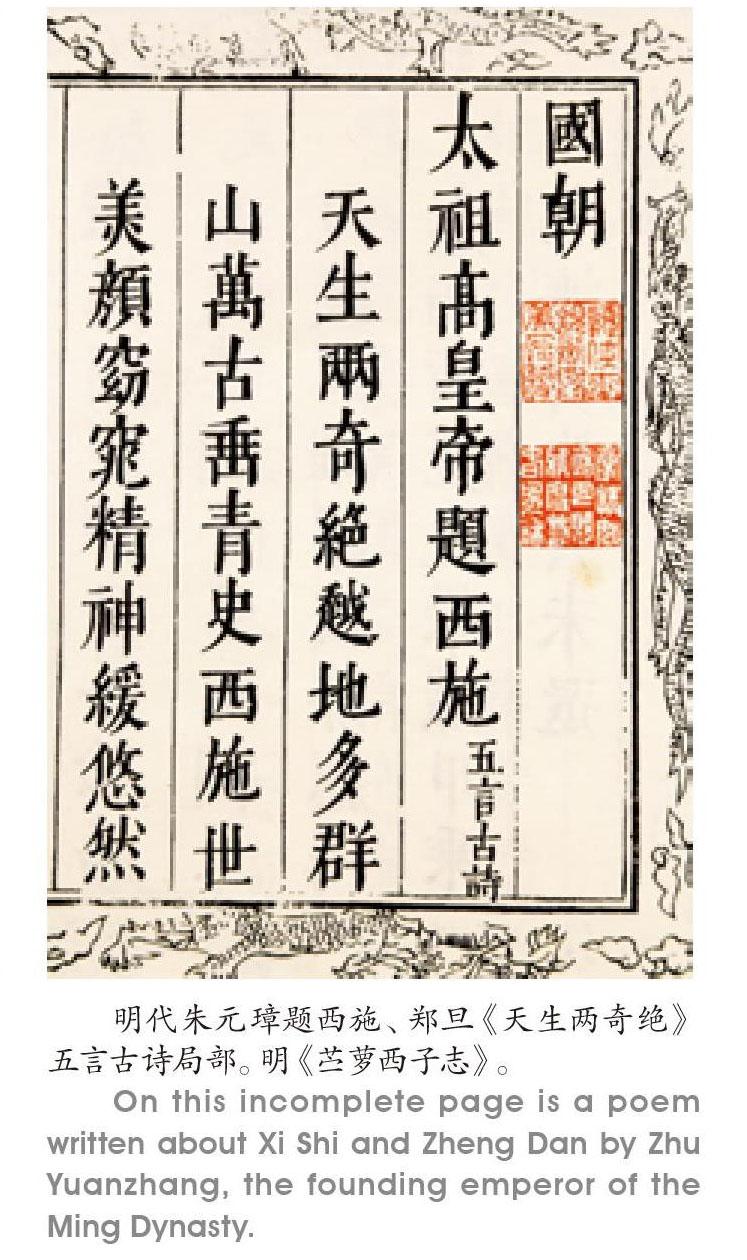古往今来话西施
2020-09-26陈侃章
陈侃章



▲史学篇
2006年5月20日,中华人民共和国国务院公布第一批国家级非物质文化遗产,将西施传说纳入其中。
世上本没有传说,有了文化记忆才产生传说。当这种传说依附于真实的历史人物,且这个人物又是一颦一笑、顾盼生辉的邻家女孩,那么这种传说便真切可感,令人津津乐道无穷期——西施的故事,就诞生于那段“生聚教训”的经典历史中。
西施其人
春秋战国时期,吴越两国互相攻伐。公元前494年,吴国击败越国,越王句践屈膝求和,随之入吴为人质。在吴服役之日,句践尝尽人间悲苦。为求生获释,低声下气,对吴王执礼极恭。越国政事由文种主持,外屈内躬,百般调和,并以重金贿赂吴国太宰伯嚭(pǐ)。公元前490年,吴国终于释放了囚禁三年的句践。
句践归国,发誓洗雪这奇耻大辱,便卧薪尝胆,广开言路,制定并实施九项兴越灭吴之策,其中第四术据“吴王淫而好色,宰嚭佞以曳心,往献美女,其必受之”的特点而制订。几经寻觅后,终于在诸暨苎萝山找到超尘脱俗的西施和郑旦。
西施,相传姓施,名夷光,世居诸暨苎萝山下(今浙江省诸暨市城南),苎萝山下有东西两村,夷光居西村,故名西施。苎萝山又名罗山,山不高而挺拔,林不茂而奇秀,苎叶苍翠,葛萝片片,因盛产“如丝之苎”,故名。浣江流经山下,略呈回流,复向东去。西施父卖柴为生,母浣纱为业,西施幼即浣纱,世称“浣纱女”,天生丽质,为绝世之美人。
鄭旦,字修明,与西施同为苎萝山下女,居浣江东侧,亦美艳绝伦,与西施同时被选中。
句践践恐乡女鄙朴,就把她们安置到越国都城会稽(今绍兴)土城山,学习宫廷歌舞礼仪,三年乃成。并由范蠡将西施、郑旦护送到吴都苏州,献于吴王。夫差喜形于色:“越贡二女,乃句践之尽忠于吴之证也。”吴国重臣伍子胥据史引例,力谏不可纳贡。然夫差终不听谏,遂纳西施、郑旦为宠妃,沉溺其间,不能自拔。李白有诗感叹:“姑苏台上乌栖时,吴王宫里醉西施。吴歌楚舞欢未毕,青山欲衔半边日。”
显然,西施、郑旦是句践送给吴王极为重要的贡品。面对国亡家破之痛,兴越灭吴是越国上下一致的誓愿。从最低限度上说,作为青年女子,她们作出了自己所能作出的最大牺牲。毫无疑义,西施、郑旦为“十年生聚、十年教训”的复仇雪耻计划作出了历史性贡献。
关于西施的记载,首先散见于先秦诸子百家。《墨子》云:“西施之沉,其美也。”来到两汉,提到西施的书也很多。唐宋元明清各代史册地志,记载西施、郑旦不胜枚举,且多有浓墨重彩之笔。
西施、郑旦等人,在文物上也有体现。在越国故都绍兴出土的汉代“吴越人物画像铜镜”上,画面围绕吴越两国君臣人物展开,镜背以四分法分布,分别是吴王、伍子胥、越王和范蠡以及越女二人。吴王气愤填胸,侧目怒视伍子胥;伍子胥慷慨激昂,拔剑作自刎状;越女二人宽袖长裙,粉面含春,亭亭玉立于宝器旁;另一区间,越王句践和范蠡踌躇满志,洋洋自得。
而珍贵的青铜器吴王夫差盉,穿越两千多年的风云,于1995年款款进入专家视线。这件青铜器造型古朴典雅,上海博物馆以重金从香港引入内地。盉的肩上刻有铭文,是献给“无名女子”的礼品。春秋时的青铜器,均为上层贵族所独享,然该青铜器上并未标明女子姓名、称号,说明这个女子原本地位低下,但又为夫差所宠幸,这与西施的经历相吻合。专家们综合分析后认定,这是夫差送给西施的“爱情信物”。
当年,西施由越入吴,与范蠡相伴而行,一个柔肠百转,一个策马盘旋,步履迟迟、互道珍重,肩负重托、莫知我哀。那一幕幕荡气回肠、亘古流传的历史话剧就这样徐徐拉开帷幕。
西施之美
西施之美,在先秦诸子的文字中屡见。在《慎子》中,西施是天下最漂亮的女子。在《庄子》中,西施之美颜玉容被描写得栩栩如生。“西施病心而颦其里。其里之丑人见而美之,归亦捧心而颦其里。”西子捧心,东施效颦,这个对比鲜明的成语就由此而来。
《孟子》认为,即使美如西施,也应爱怜,否则“西子蒙不洁,人皆掩鼻而过之”。体察这句话,还有一层含义值得重视:对西施的尊敬。孟子并不仅限于其美艳,“子”这个称呼,即使用在男人身上也是难得的尊称。然孟子却将“子”加诸一介“浣纱女”,可谓尊荣复尊荣,开启百代崇敬之路。
时光流逝,纵贯千年,大才子苏东坡横空出世。这位杭州太守面对西湖触景生情,别有意味地将西湖形象升华,于是有了“欲把西湖比西子,淡妆浓抹总相宜”这一千古名句,巧妙地把中国人的景观审美习惯,有机糅合到天人合一的哲学境界。从此“西子湖”的美称流播八方,西施与山水美景交融相伴,互相成就永恒。
西施影响的广泛深远,形象的真实丰满,借助于文学作品栩栩如生的描绘,深入人心。
东晋王嘉《拾遗记》描写了西施、郑旦的惊世容颜。吴国将西施、郑旦“处于椒花之房,贯细珠为帘幌,朝下以蔽景,夕卷以待月,吴王夫差目之,若双鸾之在轻雾,沚水之漾秋蕖。”
《全唐诗》录存唐进士王轩与西施对吟,可谓足够浪漫。王轩跋山涉水来到诸暨,云游苎萝山,泊舟浣纱溪,凝视浣纱石,坠入其中而不能自拔,乃趁兴题诗石上:“岭上千峰秀,江边细草春。今逢浣纱石,不见浣纱人。”西施闻声,飘然现形,答曰:“妾自吴国还越国,素衣千载无人识。当日心比金石坚,今日为君坚不得。”这跨越时空的两情相悦,比之当下历史穿越剧毫不逊色。
至元代,许多敷演西施史事的杂剧出现,其中首推关汉卿《姑苏台范蠡进西施》。而伊世珍的《瑯嬛记》则将西施写得“妙不可言”:身体散发异香,每次沐浴完毕,宫人争先恐后把西施沐浴之水存放到缸里,然后用松枝蘸着,洒到门窗板壁上,顿时香气满室。
明代诸暨的《苎萝西子志》,汇集了江浙数十位知府知县,还有翰林、尚书和一大批进士、举人的诗文。这176位饱学之士,摹其明眸善睐之风韵,状其颦眉捧心之丰仪,洋洋洒洒,共同为西施唱一曲千古赞歌。卷首为开国皇帝朱元璋的《天生两奇绝》五言古诗,把西施、郑旦提到一个前所未有的高度。有了“皇恩浩荡”,此书自然不同凡响,穿越岁月风烟,依然厚重扎实。
《红楼梦》第六十四回,曹雪芹运用对比手法借林黛玉之口说出:“一代倾城逐浪花,吴宫空自忆儿家。效颦莫笑东村女,头白溪边尚浣纱。”表达的意思很清楚:一代倾城美女已随浪而逝,只有东村效颦女子平安白头至今。真所谓红颜者薄命矣!
《东周列国志》的说法有了变化:句践夫人出于女人之妒,不容置西施于越王之旁。“句践班师回越,携西施而归。越夫人潜使人引出,负以大石,沉下江中,曰‘此亡国之物,留之何为。”
西施歸隐山林说。越国得胜归来,西施不恋荣华富贵,恳求回家侍奉双亲,终老山林。后在浣纱时失足落水而亡,想必是宫中盘桓多年,当年娴熟技艺荒废所致。宋之问亦说:“一朝还旧都,倩装寻若耶。鸟惊入松萝,鱼畏沉荷花。”此处所云“旧都”,即指越国原都城诸暨,以区别于后来迁到会稽的新都城会稽。串连这些诗句,西施“归隐山林”之说呼之欲出。
关于西施的下落,虽有诸说,但或浮或沉,或隐居湖畔,或失足落水,都没有离开江湖河水。看来,这位自幼与水为伴的浣纱女子,最终还是在流水中找到归宿,岂非命运使然?
Xi Shi the Beauty: Legend of 2,000 Years and More
By Chen Kanzhang
Xi Shi (506BC-?), now part of cultural signatures of Zhejiang, was one of the renowned Four Beauties of ancient China. She was said to have lived during the end of the Spring and Autumn period in Zhuji, the capital of ancient State of Yue. Her legend is not wholly about her beauty, but largely about her engagement in a long-term strategy of the Yue State to take a revenge on its arch-enemy Wu State. She is said to have contributed to the eventual downfall of the Wu State.
King Goujian of Yue was defeated in a war and then imprisoned by King Fuchai of Wu. Yue later became a tributary state to Wu. Secretly planning his survival and comeback and revenge, Goujians minister Wen Zhong came up with a set of strategies. One of the plots was to train beautiful women and offer them to the King of Wu State as a tribute (knowing Fuchai could not resist beautiful women). Fan Li, another minister of King Goujian, found Xi Shi and Zheng Dan, two young girls from Zhuji, and gave them to Fuchai in 490BC.
In 1995, Shanghai Museum purchased a bronze object from Hong Kong. The object was a gift traced back to King Fuchai of the Wu State. It was a gift from the king to a woman whose origin of family and name were not important enough to be engraved on the bronze piece. Experts conjectured that it was a gift from Fuchai to Xi Shi.
The beauty of Xi Shi has been discussed in historical literature since pre-Qin times. Zhuangzi (369-286BC) and Mencius (c. 372-c. 289 BC), two greatest scholars of that time, mentioned Xi Shi in their respective works. Xi Shi as a symbol of beauty has appeared in poems and essays over the last 2,000 years. Su Dongpo (1037-1101), presumably the greatest poet of the Song Dynasty (960-1279), compared West Lake to Xi Shi (known as Xi Zi as first called so by Mencius). Since then, West Lake has been widely considered named after the beauty.
She has also appeared in quite a few opera plays since the Yuan Dynasty (1279-1368). In the Ming (1368-1644) 176 scholars and government officials put together a book of poems and essays singing of Xi Shi the Beauty.
And Xi Shi has been a beauty in various folktales. A long time ago, the route she took to travel from Zhuji to Suzhou, the capital of the State of Wu, was determined by folk historians. Nowadays, the cities and counties on her way northward have historical sites in honor of her. Visit these historical sites, and you can well imagine why they were named after Xi Shi.
In Zhuji, there are many historical sites in memory of the local beauty of national renown. Some of these memorial sites date back to the Southern Song Dynasty (1127-1279). Zhuji has a Xi Shi memorial temple. And Xiaoshan, previously a rural county adjacent to Zhuji and now part of Hangzhou, also has a Xi Shi memorial temple. Yu Xuanji (844-871), a woman poet in the Tang Dynasty (618-906), wrote a poem about the temple in honor of the beauty. Qin Guan (1049-1100), a poet of the Song Dynasty (960-1279), wrote a poem about his visit to Shaoxing. He mentioned Xi Shi and her home village Zhuluo. The temple was destroyed in the 1940s by Japanese bombs. It was not until 1985 a restoration project was launched to build the temple on the previous site at the foot of Zhuluo Hill. The temple on the western bank of Huansha River was open to the public in 1990. Now on the eastern riverbank of Huansha River is a site presenting the home village of Zhuluo.
Fortunately, Huansha (fabric washing) in the handwriting of Wang Xizhi (303-361), presumably the greatest calligrapher in the history of China, is still there on a cliff surface. Wang Xizhi isnt the only ancient great who left his art there. Historical accounts document more than 20 great ancients and modern men of letters who visited Zhuji in honor of Xi Shi.
Historians do not know where Xi Shi was buried. They dont know when and how she passed away. Different stories indicate different fates of the beauty. In the Tang Dynasty, Lu Guangwei wrote in a regional history that Xi Shi retired to a life with Fan Li, a minister of King Goujian. Nobody knew where she retired. Her happy life after working undercover in the enemys kingdom and helping topple the kingdom was born out of the ideal that heroes retire to a quiet and safe and enjoyable life after colossal success. In contrast to the happy ending for the beauty, there are some tragic stories. She was executed by drowning in a river. According to Mozi (479-381BC), another great scholar of the pre-Qin centuries, she was killed because somebody was jealous of her celestial beauty. Another tale about her death points to the wife of King Goujian. Presumably the wife said that the young girl was inauspicious because she had brought down a kingdom. From this folktale it can be assumed that the heartthrob was executed in river for fear that she might bring down another.
